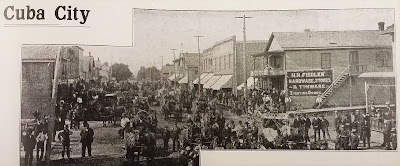Mining fever hits Cuba City
The tri-state area was long known for its prosperous lead mines, but by the early 1900s, a new mining boom had gripped the region. Improved technologies allowing miners to reach deeper ore, increased amounts of capital, and a skyrocketing market for another locally abundant mineral, zinc, spurred this new mining frenzy.
This early image of Cuba City was printed in the Complete Year Book of Wisconsin, Illinois and Iowa Lead and Zinc Mines, published by Skemp and Conley in 1906. The photograph of Main Street, facing north, captures much of the town's business district, ca. 1894-95. For a point of reference, H. H. Fiedler's hardware store on the right is Hindu's Corner Bar today.
The Year Book had this to say about Cuba City at this exciting time:
The thriving little town of Cuba City claims the distinction of containing within its immediate environments as many of the larger mining plants as any point in the district. It is a bright business spot in the best end of the zinc range and contains a population of eleven hundred people. The mining boom has struck the town in earnest and the coming summer will mark the construction of several hundred houses and a corresponding increase in population. One of the good features of Cuba City is the fact that it is not compelled to rely upon the mines alone for its thrift, but is in the richest section of the stock-raising district of southwestern Wisconsin. Cuba City is bound to become a prominent point in the new El Dorado.Skemp & Conley's mining year book is available online: Complete Year Book
Cuba City as seen in the accompanying picture is only an illustration of one of its busy days and the merchants and wide-awake citizens who make up its community know no such word as fail.



Comments
Post a Comment